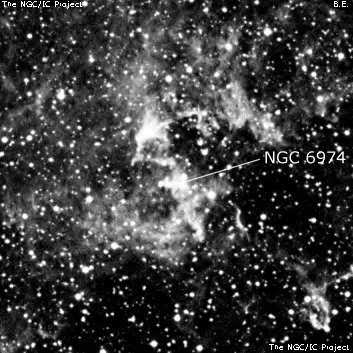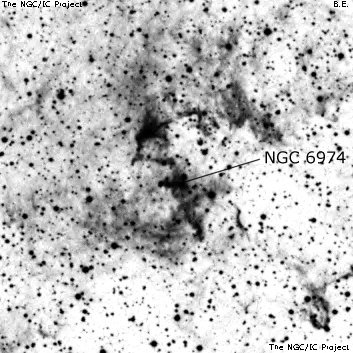NGC/IC Project Restoration Effort
(This is a very very beta version)
NGC6974


Basic Information
Location and Magnitude
Right Ascension: 20:51:4.0
Declination: +31:49:54
Constellation: CYG
Visual Magnitude:
Historic Information
Discoverer: Parsons L.
Year of discovery: 1873
Discovery aperture: 72.0
Observational
Summary description: Neb *, neby cE pf
Sub-type: SNR
Corwin's Notes
=====
NGC 6974 was found by the fourth earl of Rosse on 20 August 1873, and is
probably part of the Veil Nebula (see N6960 for general comments on this huge
supernova remnant). However, LdR's nominal position for it falls in a pretty
empty patch of sky inside the main loop, well away from any bright nebulosity.
His description in full reads, "Nebulous *, neby cE pf, RA = 20h 45.5m, NPD =
59d 50'+-." Dreyer assumed the equinox of the position to be the epoch, and
precessed it to 1860 for the NGC entry.
Searching in the area of the Veil suggests a couple of nebulous patches that
might be LdR's nebula. One of these is IC 1340, actually found in September
1866 by Truman Safford and given in the NGC Appendix where it is number 51 in
Safford's list. The second is a few arcminutes to the northeast. Either of
these might match LdR's description, if not his position.
RNGC has a position (20 50.8, +31 52; J2000) about 1.2 degrees north of LdR's
nominal place. This, too, lands in a pretty empty patch of sky, but five or
six arcminutes to the southeast are some brighter patches of nebulosity.
However, they have no obvious star associated with them, and are not obviously
extended in any particular direction, let alone east-west. So, even though
Wolfgang Steinicke also chooses this as LdR's object, I've marked the
identification questionable.
Another, less likely, possibility is that N6974 is one of the 20 or so
observations of NGC 6960 made with the 72-inch reflector. In this case, the
position error would be in RA (5 minutes too large), and the description would
have to read "cE ns." The star would be Kappa Cygni which JH took for the
position of NGC 6960. I offer this as just a possibility, however, and do not
even list it in the position table.
Finally, I should mention that another NGC problem due to the 4th earl, NGC
4912/13/16 (which see), has a solution that also involves a large position
error. So, while these suggestions for NGC 6974 may seem to be plucked off
the sky at relatively large distances from LdR's nominal position, they may
not be all that unusual.
All in all, I am inclined to go with IC 1340 or its companion. This is
reflected in the number of question marks on each object listed in the
position table.
Steve's Notes
=====
NGC 6974
18" (8/3/11): although the NGC position (from the 4th Earl of Rosse) is 74' further south in an empty section of the Veil, this number is generally applied to the southeast end of the 25' section of nebulosity between the north end of Pickering's Triangular Wisp and the north end of NGC 6992/5 (eastern section of the Veil). This patch is roughly 4'x2.5' in size and contains three brighter stars. A thread of nebulosity extends NW and then spreads out at the NW end (see NGC 6979). Extremely faint haze extends at least 20' SE towards a slightly brighter patch (see notes on section G).
18" (7/31/08): at 73x (31mm Nagler) and an OIII filter, this is a locally brighter patch at the SE end of a 25' elongated section of the Veil to the east of the northern end of Pickering's Wedge. Although not plotted on Megastar, Uranometria or MSA, very faint nebulosity continues to stream to the SE throughout most of the 1.1¡ field of the 31mm Nagler and ending near a slightly brighter patch (see notes on piece G) at 20 51.1 +32 23 (2000).
17.5" (9/7/91): smaller southern portion of a very faint elongated patch with NGC 6979 in the Veil Nebula. Several faint stars are superimposed. Located east of the north edge of the widest section of the huge triangular wedge of nebulosity in the center of the Veil. Also see NGC 6979.
The NGC identification is very uncertain as the 4th Earl of Rosse's position was 74' further south and there is no nebulosity near his position.



